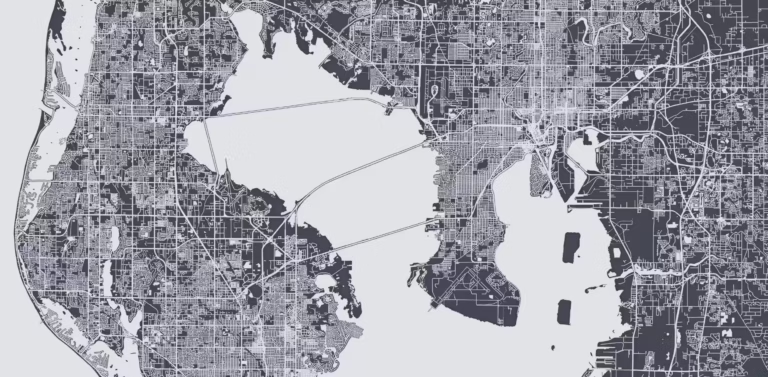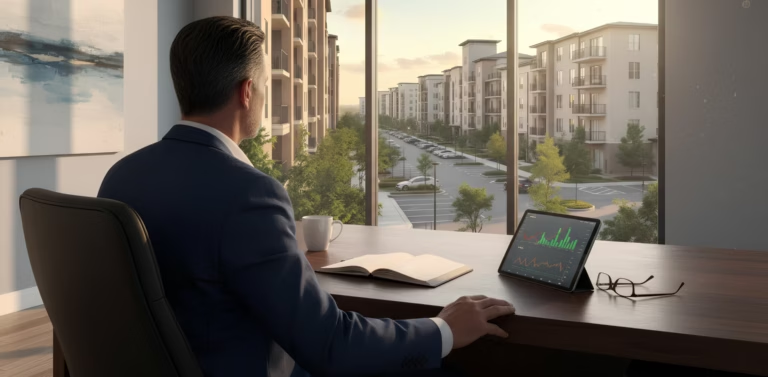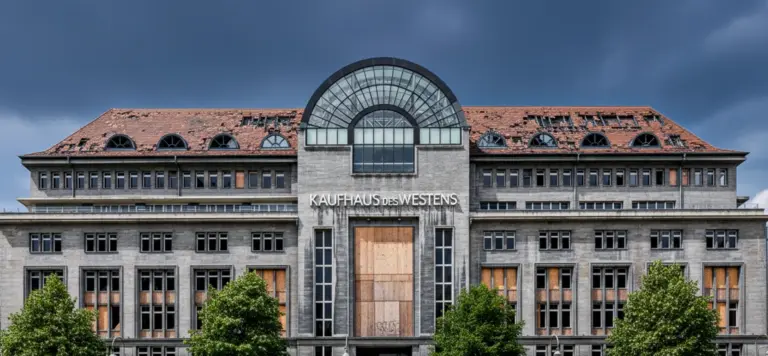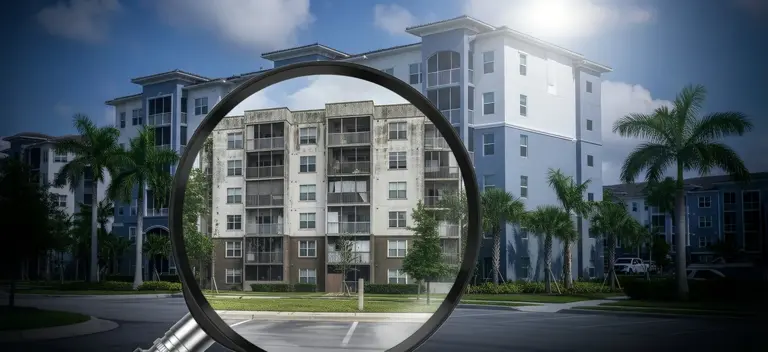If you walk through a busy residential complex where almost every window is lit up, you immediately sense a feeling of stability: people live there, rents seem to be flowing, the property looks solid. This perception is understandable – and deceptive.
This is because it only describes what is visible: the physical occupancy. However, something else is crucial for investors:
1. Why full buildings do not automatically mean stable yields
Physical occupancy indicates how many units of a property are occupied. It is easy to measure, easy to communicate – and is often the focus of exposés and financing documents. “Almost fully let” sounds reassuring, but is only half the truth.
The decisive factor is how much of the theoretically possible rental income is actually collected. This second key figure, economic occupancy, is the real compass for the economic health of a property.
The formula is simple – its consequences are not:
Economic Occupancy = actual income ÷ potential income at full occupancy at market rent
If economic occupancy falls, the property loses substance. Losses are incurred through discounts, deferrals, vacancies or bad debts.
An example illustrates the dimension: a house with 100 units, market rent USD 1,000 per unit results in theoretical income of USD 100,000. 95 units are occupied, i.e. 95 % physical occupancy.
However, after downtime, free months and discounts, only USD 80,000 of income remains – Economic Occupancy = 80%. The building appears stable, but loses 20 % revenue every month.
2. Physical vs. economic occupancy - the decisive levers
There are many small differences between “rented” and “paid” that add up to large effects. The most important influencing factors are
- Loss-to-lease: Contracts below market rent – usually the result of outdated price structures or an overly cautious adjustment policy.
- Concessions: Rent-free months or discounts that bring quick rentals but reduce cash flow.
- Delinquencies: Late or defaulted payments; their share increases significantly in phases of economic uncertainty.
- Bad debt: Receivables that are no longer recoverable and have a lasting negative impact on economic stability.
Analyses by the Urban Land Institute (ULI) show that even modern properties regularly lose 5-10% of their potential yield due to these factors.
High physical occupancy indicates demand – high economic occupancy proves sustainability.

Banks and investors pay close attention to cash flow. Physical occupancy may seem reassuring at first glance, but the bank is ultimately only interested in one thing: will the mortgage be paid?
- With high physical but low economic occupancy, a property looks good but does not generate any money.
- With low physical but stable economic occupancy (e.g. through high-quality, solvent tenants), a property can be healthier than it looks.
It becomes particularly critical when tenants “take advantage of the system”: If someone does not pay for several months, you as the owner are left with the costs for maintenance, operation and loans. This can very quickly become more expensive than if the apartment were empty.
3. Where revenue is lost - and how economic occupancy can be controlled
In practice, the quality of management determines whether reliable cash flow is generated from occupancy. There are several levers between market rent and actual incoming payments that need to be known and controlled.
| Factor | Effect on cash flow | Professional management |
|---|---|---|
| Concessions (discounts, free months) | Accelerate leasing, reduce revenues | Targeted, temporary use; regular market review |
| Delinquencies & Bad Debt | Direct payment default | Credit checks, deposits, clear collection processes, proactive communication |
| Loss-to-Lease | Old contracts under market rent | Regular adjustments upon lease expiration |
| Turnover vacancy | Days without revenue between tenants | Standardized make-ready processes, pre-leasing, service level agreements |
As studies by the Institute of Real Estate Management (IREM) and the National Apartment Association (NAA) show, a permanently stable economic occupancy rate of over 90% is no coincidence, but the result of process quality and disciplined asset management.

4. Why economic occupancy determines value
In the professional investment business, it is not the “fullest” but the most viable house that is valued. Every percentage point of economic occupancy translates directly into cash flow – and therefore into value.
If three percentage points of economic occupancy are missing, the property value is reduced by around six percent at a cap rate of 5%. Cash flow stability is therefore not a detail, but capital preservation.
As the Urban Land Institute and the National Multifamily Housing Council (NMHC) show, there is a clear correlation between economic occupancy and portfolio performance: stabilizing income secures value.
5. Transparency through reporting - control instead of emotion
Professional reporting always presents physical and economic occupancy side by side. Not as a snapshot, but over time – supplemented by the revenue bridge from contract to cash receipt.
Yield bridge: Gross Potential Rent → Concessions → Loss-to-Lease → Vacancy → Delinquencies → Bad Debt = Collected Rent.
Leading indicators: payment rate up to day 5, aging report, make-ready duration, proportion of renegotiated contracts.
Benchmark: According to IREM, an economic occupancy of ≥ 90 % is considered a solid threshold.
These key figures are not an end in themselves – they make visible where revenue is generated and where it is lost. This is how management becomes control.

6. What economic occupancy means for investors
For institutional and experienced investors, economic occupancy is far more than just a key figure – it is the touchstone of any earnings forecast.
- In purchasing, it shows whether business plans are realistic.
- In the portfolio, it measures how efficiently management and the market interact.
- In the exit, it determines the multiplier – buyers calculate cash flow, not backdrop.
If you only assess physical occupancy, you are investing in sentiment. Those who assess economic occupancy invest in substance.
As the National Multifamily Housing Council points out, the long-term success of a portfolio depends less on its size than on the stability of its income.
7. A look behind the numbers
Economic occupancy is essentially a measure of discipline. It shows how income is consistently secured, processes are managed and risks are identified at an early stage. In markets with uncertainty, this discipline determines the resilience of an investment.
If you want to understand whether a property is sustainable, you have to look behind the facade – at contract structures, payment histories, adjustment speed and tenant behavior. This is not abstract controlling, but applied risk management.
A high physical occupancy rate is reassuring – but it is no substitute for creditworthiness.

8. Conclusion
Physical Occupancy shows who lives in the apartments.
Economic Occupancy shows who pays the bills.
The difference between impression and yield lies between the two.
For investors, this means that it is not the number of tenants that determines stability, but the reliability of their payments.
A full house can be deceptive – a paying house carries.
That is why Whitestone focuses every analysis on the key figure that proves substance: economic occupancy.








